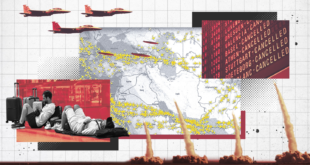The year may have only just started, but US troops in Iraq and Syria have already come under attack by drones three times. It is worth noting that, in both countries, the US presence has decreased. In Syria, there are mere hundreds of US troops left in the northeast of the country for counterterrorism purposes. In Iraq, the number is below 2,500 and troops have ended active combat to shift into an advisory role. In both countries, the main goal is now focused on fighting Daesh, yet most of the attacks against them are coming from Iranian-backed groups.
The reductions in troop numbers and the shift in their roles come at a time when the US is negotiating with Iran in Vienna. It is clear that Tehran is directing these attacks to push its message and apply pressure on Washington. The mullahs are convinced that the US will not retaliate or respond strongly to avoid any escalation. The use of weaponized drones is very efficient in its asymmetry and capacity to create irritation without being important enough to provoke a strong military response. It is also an effective communication tool from Iran that underlines its capacity to rain drones and missiles and make life even more difficult for the US.
There is a growing parallel between the Taliban’s objectives in Afghanistan and Iran’s objectives in the Middle East. The goal is now clearly to push for a full withdrawal of US troops from Syria and Iraq. Tehran is comfortable in its thinking that, through pressure in the negotiations in Vienna, as well as through the official political voices from the Iraqi and Syrian governments, it can corner US forces. America has already noticed that, since its withdrawal from Afghanistan, it now has difficulty assessing the counterterrorism risks, especially concerning the links between the Taliban and Al-Qaeda and what the implications are for US national security.
The American military hence understands that a withdrawal from Iraq and Syria would mean more difficulties when it comes to its counterintelligence missions in both countries. This applies not only to Daesh, but also and mostly to all Iranian-sponsored terrorist activities. Unlike during the 2015 Joint Comprehensive Plan of Action negotiations, declarations from US military officials have been more direct in condemning the Iranian proxies and forces, blaming them for the attacks and warning them of potential retaliation. Some military experts state that the small numbers of US forces in both Syria and Iraq are more like hostages than a deterrent.
Last November, a bipartisan group of members of the House of Representatives raised legal questions regarding US military activities that do not involve Daesh. Their letter specifically questioned US airstrikes on sites in Syria that are used by Iran-backed militia groups. It implied that former President Donald Trump and his successor Joe Biden stretched the current legal authorizations with the missions in Syria instead of seeking the approval of Congress. The goal of this letter was to avoid future legal loopholes that could permit more “endless wars.” However, it also means that they consider US military activities in response to Iranian aggression as outside of the current legal scope, so the Iranian terrorist proxies are indeed in luck.
There is an objective from the US to continue its withdrawal from the region and so the question remains whether this will be executed without reducing the pressure coming from Iranian-backed forces. Could a new surge be the solution instead? In 2007, President George W. Bush ordered the deployment of more than 20,000 soldiers in Iraq with the aim of enhancing the general situation to allow for reconciliation and a state-building process. Gen. David Petraeus took command of the Multi-National Force in Iraq and achieved his mission’s goals. But it is highly doubtful that the current US administration would, or even could, follow such a strategy, especially as it views that the same strategy failed in Afghanistan. This leaves the US with few options.
This lack of clarity — whether on the US military’s role or the legal aspect of its operations — underlines the lack of an overarching strategy, not only for Washington’s military presence in both Syria and Iraq, but also on its geopolitical objectives. This has become true for the entire Middle East just as it was true for Afghanistan. The US military, which is trying to maintain a difficult balance and stability despite its small presence, is left fending off Iranian provocations, especially in northern Syria, where the various actors’ roles and alliances are blurred. This situation is in no way sustainable, especially when Russia and China are more assertive in their engagement in the Middle East.
It is similar to the situation in Afghanistan, where the file was passed from one US administration to the next until it reached a point where no one really remembered what the original goal was and what could still be achieved. Therefore, looking at the geopolitical arrangements in Syria and Iraq, everything indicates the pursuit by the Biden administration of an honorable exit. The rehabilitation of Bashar Assad and the new political arrangements in Iraq point to that goal. The political landscape in Washington is also inward-looking to avoid the repetition of such forever wars, rather than maintaining regional security. However, this scenario will only become a reality with a nuclear deal. Tehran understands this and will try to make this exit as painful for the US as its departure from Afghanistan.
 Eurasia Press & News
Eurasia Press & News



